The Victor Masayesva 1981 film of Itam Hakim Hopiit film visits the culture of the Hopi that are left on the Second Mesa. This film does not contain anything about American civilization, rather the entry of the Spanish. But the film was purely to tell the Hopi story in a Hopi language and Hopi manner.
I think it is useful to watch the film in Hopi with and without the subtitles of English voice over. The story, as the article "Seeing with a Native Eye" points out, is completely led by the "complex concept of narrative structure in which the content of the storytelling is of critical important to the sense of the film."
We are shown the origin tale of this particular tribe and the oral tradition is important to pass on to the youngest generations even though they may be too young, they understand its importance. Either way there is this hypnotizing mood that the Hopi storyteller places you in. It may be the association of images and the storyteller's voice that places the viewer in a trance. "As a filmmaker, Masayesva's presence is felt. It is his mind and imagination that selects and captures images of activites and traditions that form and sustain Hopi culture."
There are questions that Faye Ginsburg in the essay "Parallax Effect" brings up that helps take a look at the film.
"Specifically, I am interested in how indigenous film and video offer productive challenges to the assumptions of the genre of ethnographic film by (1) reframing questions about the representation of cultural differences; by (2) highlighting mediamaking as a dimension of contemporary (and historical) social, cultural, and political processes; and by (3) expanding the discursive field that can bring a variety of subjects into conversation around questions raised by these media as they travel across boundaries of difference. "
I think an important fact that was not addressed in the film because of the overwhelming effect that the film has is the presence of the camera.
Ginsbury writes, "The legitimacy of one's presence with a camera in any setting (especially when power relations are unequal) should always be raised, not simply as a textual question referred to through reflexive cinematic strategies, but in social relations that are secured before a film or video project even begins." Before this she wrote, "The making of images by anyone, whether by 'outsiders' or 'insiders,' is problematic when ethical and social rules..." Ginsbury goes on to talk about how that just because one is an "insider" does not mean that there would not be a problem with their own subject.
Because there is not outside source that the filmmaker is addressing, there could be something from the filmmaker's own community that they could find problematic.
Friday, December 14, 2007
Number Our Days
The 1976 film by direct Lynne Littman "Number Our Days" however depressing that it may make us feel was a beautiful film about the aging process. In Venice Beach, CA we are shown the elderly center particularly for the Jewish community of that city. It is a place where one can make friends, be feed, sing, dance, and be merry. Or so this is their mission.
This film shows the never ending struggle for respect and a sense of belonging. Although the elderly in this film do not long to be alive for much longer as most of everyone has passed away, there is a trait that they have attained which is a lack of fear of death.
Although Littman's voice-over was slightly on the corny side at times, I think it proofed the point that this project was an extremely close one to her. It is a personalization effect.
The clips of the old woman in her apartment talking about her choices in life (entertainer or wife), the close up shots of the old woman crying for her lost son, of the woman who wanted to thank everyone in the center for including her into the "family" are both beautiful and heart breaking.
There is no doubt though however that one who has not thought about her before, would have a different perspective of an elderly person. That they are not just the bitter pasts of the earth walking around in the world. Yes, they are the past, but they want to impart their knowledge. They are containers of wisdom, and to take advantage of their stories and not toss them aside would be a wise thing to do itself.
This film shows the never ending struggle for respect and a sense of belonging. Although the elderly in this film do not long to be alive for much longer as most of everyone has passed away, there is a trait that they have attained which is a lack of fear of death.
Although Littman's voice-over was slightly on the corny side at times, I think it proofed the point that this project was an extremely close one to her. It is a personalization effect.
The clips of the old woman in her apartment talking about her choices in life (entertainer or wife), the close up shots of the old woman crying for her lost son, of the woman who wanted to thank everyone in the center for including her into the "family" are both beautiful and heart breaking.
There is no doubt though however that one who has not thought about her before, would have a different perspective of an elderly person. That they are not just the bitter pasts of the earth walking around in the world. Yes, they are the past, but they want to impart their knowledge. They are containers of wisdom, and to take advantage of their stories and not toss them aside would be a wise thing to do itself.
Wednesday, December 12, 2007
La Purisima
Part of Ethnography is to take a look at various cultures and their rituals, everyday occurrences. Religion is a big aspect to regard when studying people. With Yanonmami it was the trance-like spiritual cleansing that involved physical regurgitation. In Nicaragua, from late November to early January people participate in La Purisima, the Immaculate Conception of a the Virgin Mary.
The following components are necessary for a successful celebration:
A statuette of the Virgin Mary that must be on loan and blessed from a near by church
Rented chairs
Nacatamles
Nicaraguan candy
Nicaraguan toys (carved whistles, trinkets and the like)
Chicha (pink sweet corn juice)
Nacatamales (a larger version of tamales)
Program of songs to be sang to the Virgin
Rosary
Coffee
Fruits
There are three different methods to celebrate this
1) Hosted by the church
2) At one on a specific date
3) Traveling to houses (In a Halloween fashion)
I make the Halloween comparison because people will go from house to house and in order to receive food or drink (coffee) they must pray one mystery of the Rosary and sing to the Virgin. From the movies gathered below, most of them are from Nicaragua.
Here in the United States there are still Purisimas held by those that immigrated during the Sanidinista era in Los Angeles and Miami (those are the most well-known).
In the U.S., it is much more of a recollecting of Nicaraguan patriotism. I have never been to a purisima in Nicaragua. But when in purisima, here in the states, there is a chant that the gatherers will always say
Quien causa tanta alegria? La concepcion de Maria!
Que viva Nicaragua! Que Viva!
Which basically translates to : Who is the cause of all this happiness? The Virgin Mary.
It is this pride that people carry with them when they go these purisimas. Very often people will begin to talk about their pasts in Nicaragua, whether or not they still go back after having been away due to the Sandinista occupation. Most if not all Nicaraguan-American children that grow up here, know what it is to have to sit for hours, while their parents tell the stories of their childhood.
Women stay inside to gossip, while the men are outside drinking.
I used to see it as something very boring until I received the gifts to which I was later disappointed by in the evening, as the presents were fruits. But it soon became tradition. The giving of fruits is tradition, as is the tradition that you will not receive a drop of food unless you sing.
Below are clips of purisimas in Nicaragua:
The following components are necessary for a successful celebration:
A statuette of the Virgin Mary that must be on loan and blessed from a near by church
Rented chairs
Nacatamles
Nicaraguan candy
Nicaraguan toys (carved whistles, trinkets and the like)
Chicha (pink sweet corn juice)
Nacatamales (a larger version of tamales)
Program of songs to be sang to the Virgin
Rosary
Coffee
Fruits
There are three different methods to celebrate this
1) Hosted by the church
2) At one on a specific date
3) Traveling to houses (In a Halloween fashion)
I make the Halloween comparison because people will go from house to house and in order to receive food or drink (coffee) they must pray one mystery of the Rosary and sing to the Virgin. From the movies gathered below, most of them are from Nicaragua.
Here in the United States there are still Purisimas held by those that immigrated during the Sanidinista era in Los Angeles and Miami (those are the most well-known).
In the U.S., it is much more of a recollecting of Nicaraguan patriotism. I have never been to a purisima in Nicaragua. But when in purisima, here in the states, there is a chant that the gatherers will always say
Quien causa tanta alegria? La concepcion de Maria!
Que viva Nicaragua! Que Viva!
Which basically translates to : Who is the cause of all this happiness? The Virgin Mary.
It is this pride that people carry with them when they go these purisimas. Very often people will begin to talk about their pasts in Nicaragua, whether or not they still go back after having been away due to the Sandinista occupation. Most if not all Nicaraguan-American children that grow up here, know what it is to have to sit for hours, while their parents tell the stories of their childhood.
Women stay inside to gossip, while the men are outside drinking.
I used to see it as something very boring until I received the gifts to which I was later disappointed by in the evening, as the presents were fruits. But it soon became tradition. The giving of fruits is tradition, as is the tradition that you will not receive a drop of food unless you sing.
Below are clips of purisimas in Nicaragua:
Tuesday, December 11, 2007
The Museum and its Tiny Visitors
The Museum of Natural History, not only a popular tourist attraction of the city, is the magnet of schools. Students, hundreds, gather some days in the week for three hours to absorb as much information as possible with the time allotted. My mission was to get to document this. The delicate subject of attaining photos of children, will be problematic, as photos will be a sensitive entity. Requesting permission as delicately as possible, the Education Department was a blessing to me, allowing me to shadow various Teaching Volunteers around the museum.
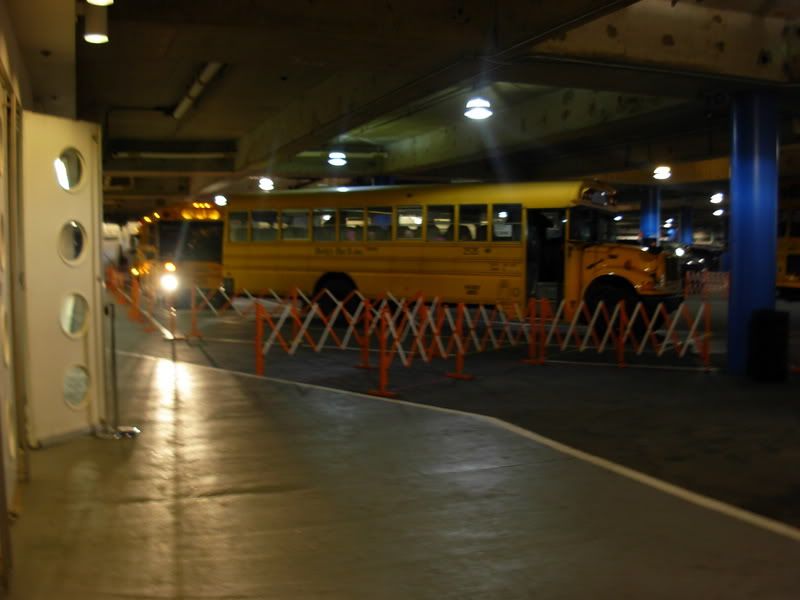
 Buses are not taken to the garage of the museum, as neighbors complained about the amount of noise that used to occur when the buses used to park out front. On this particular day, there was an expected number of 70 buses arriving to the museum.
Buses are not taken to the garage of the museum, as neighbors complained about the amount of noise that used to occur when the buses used to park out front. On this particular day, there was an expected number of 70 buses arriving to the museum.
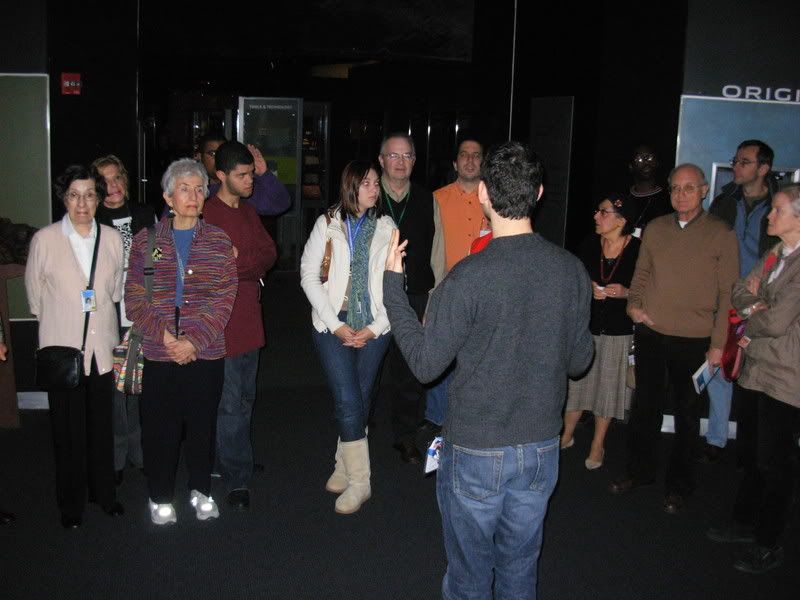 The Teaching Volunteers in this photo are the people who take different carts representing different halls (North American Mammals, African Mammals, Ocean Life) in the museum where students will travel to. On this particular, instead of being assigned to different halls like they normally are, because the program that normally shows the schedule was not working, the volunteers were given the hall of their choice. "You can tell a lot about a person from what hall they use," one of the leaders joked when people would take their time to think very carefully about where they would be teaching. After their meeting, one of the leaders gave a tour of the meteorite room, a sort of orientation, about things the volunteers could mention when showing the room to students.
The Teaching Volunteers in this photo are the people who take different carts representing different halls (North American Mammals, African Mammals, Ocean Life) in the museum where students will travel to. On this particular, instead of being assigned to different halls like they normally are, because the program that normally shows the schedule was not working, the volunteers were given the hall of their choice. "You can tell a lot about a person from what hall they use," one of the leaders joked when people would take their time to think very carefully about where they would be teaching. After their meeting, one of the leaders gave a tour of the meteorite room, a sort of orientation, about things the volunteers could mention when showing the room to students.
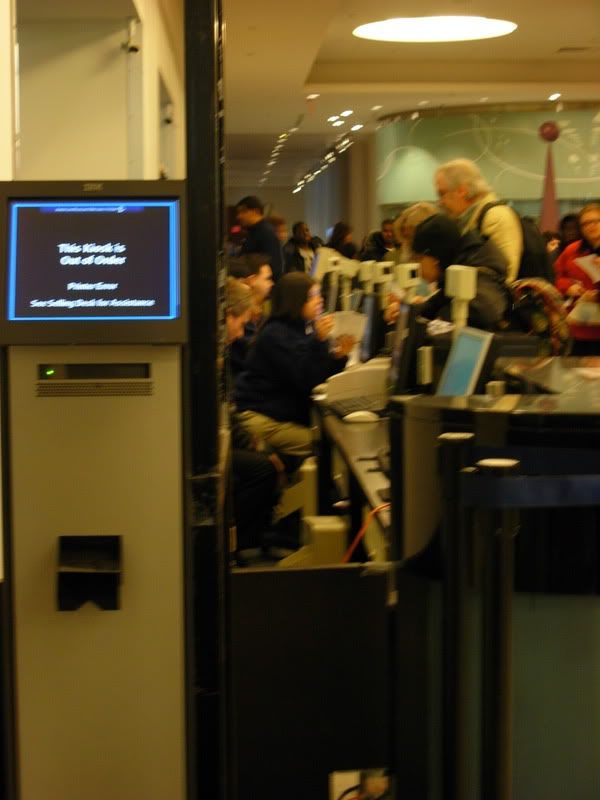
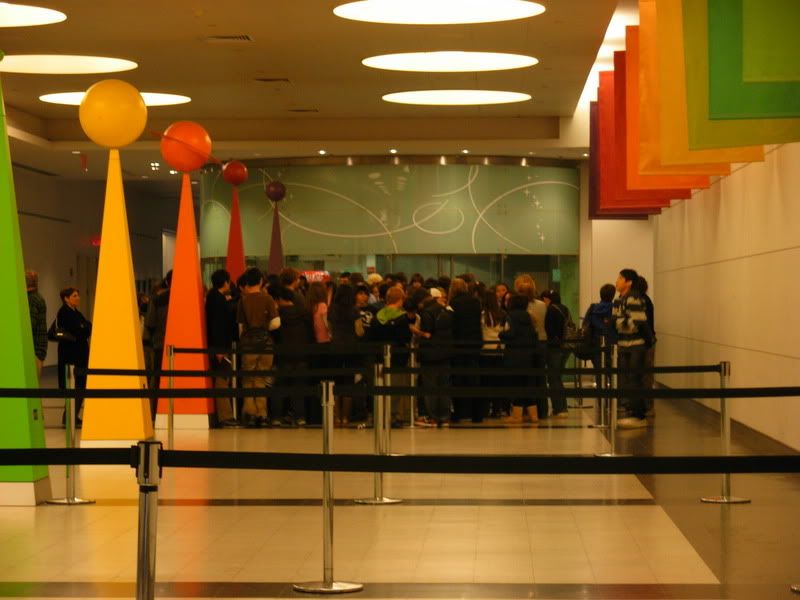 Before the students, teachers, visiting parents can enter the museum on their own, they must wait in the designated areas. This below photo was one of the first batches of groups to arrive, each section was filled at least ten minute was after the photo was taken.
Before the students, teachers, visiting parents can enter the museum on their own, they must wait in the designated areas. This below photo was one of the first batches of groups to arrive, each section was filled at least ten minute was after the photo was taken.
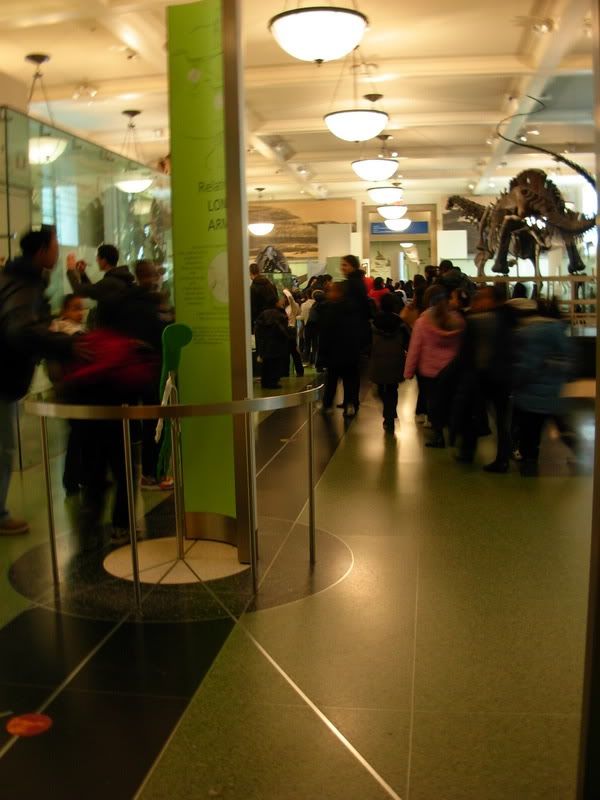
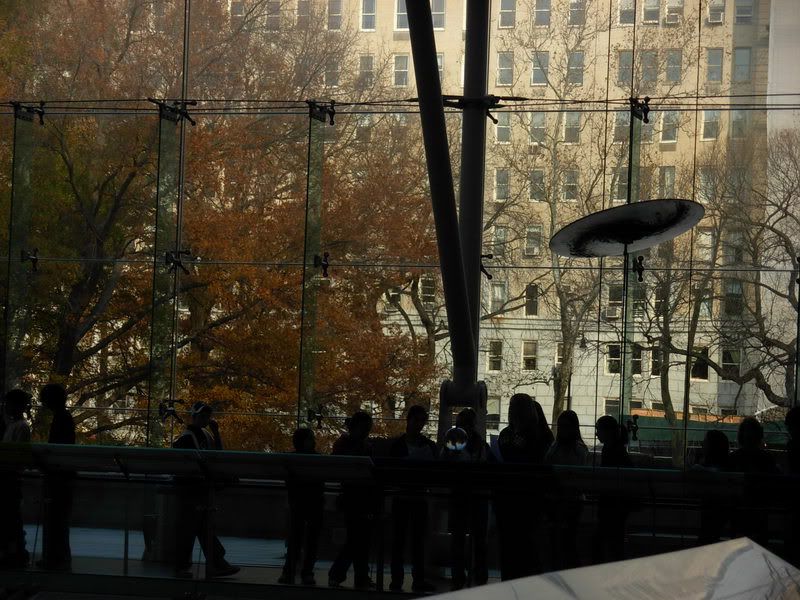
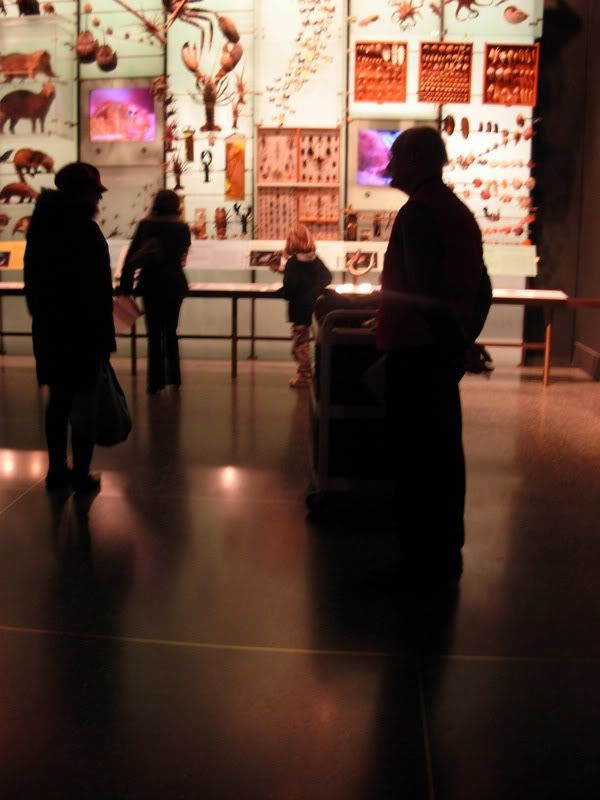
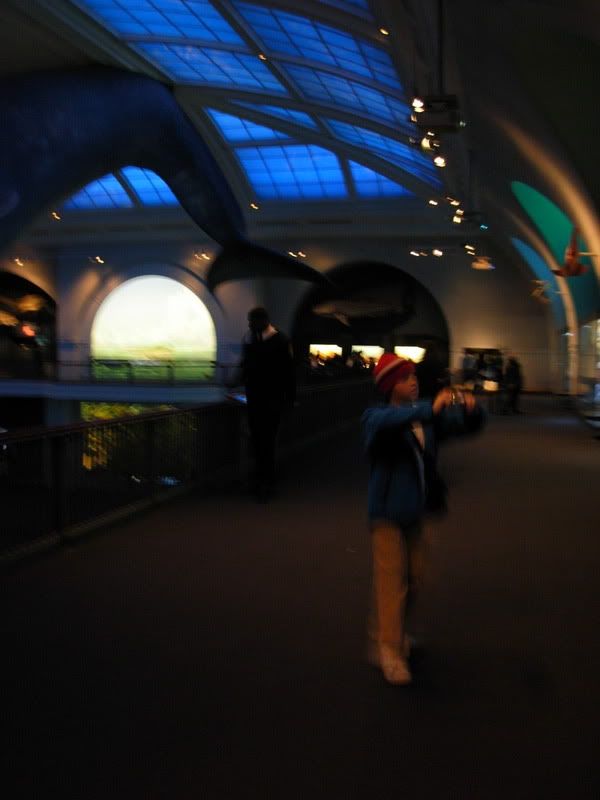
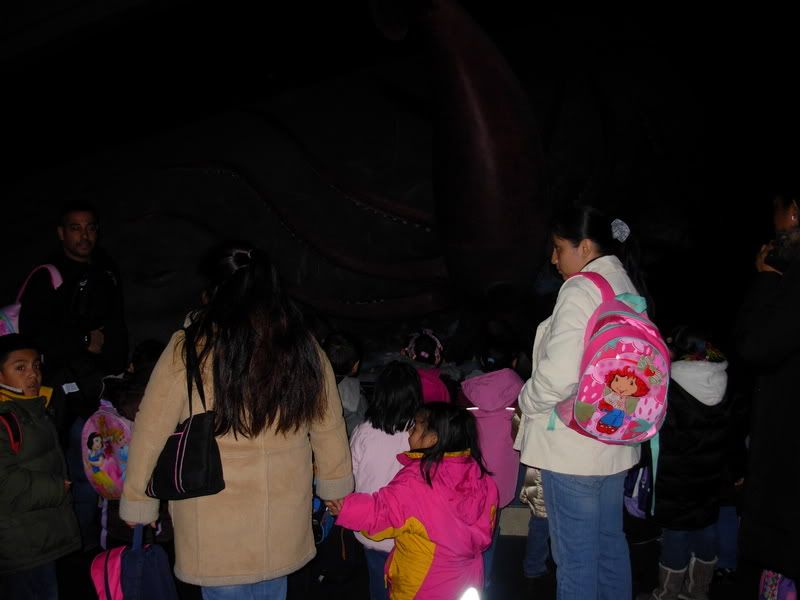
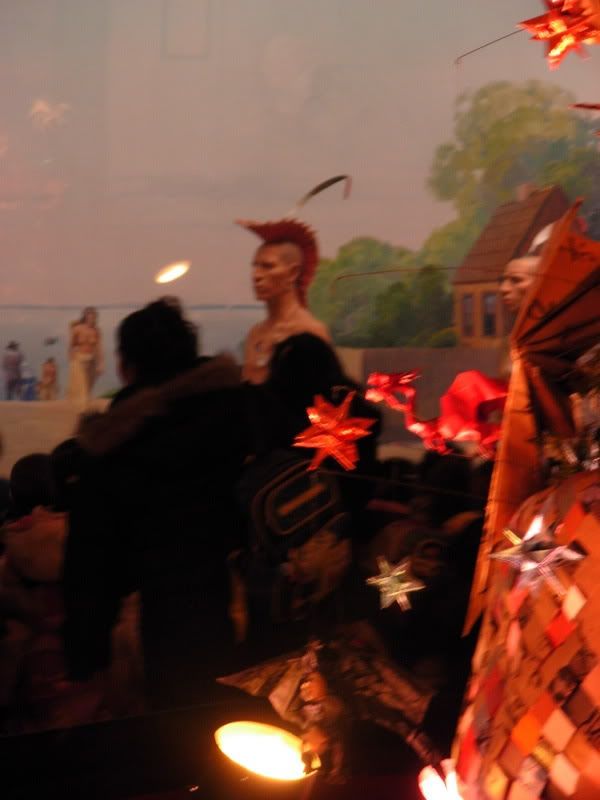
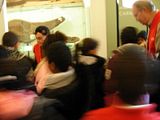
 Donna Sethi, who seemed to be my guide, like the missionary was to those who went to study the Yanomami, showed me the ropes of how things are run. She believes that the museum is more kid-friendly than other museums (MoMa, the Met) which she does admit are completely different experiences. In the Lower Level where students meet, there are various trays and boxes where schools places the children's lunch into, so that they won't have to carry them around. A lunchroom has been built (as shown above) where the students can eat at lunchtime.
Donna Sethi, who seemed to be my guide, like the missionary was to those who went to study the Yanomami, showed me the ropes of how things are run. She believes that the museum is more kid-friendly than other museums (MoMa, the Met) which she does admit are completely different experiences. In the Lower Level where students meet, there are various trays and boxes where schools places the children's lunch into, so that they won't have to carry them around. A lunchroom has been built (as shown above) where the students can eat at lunchtime.


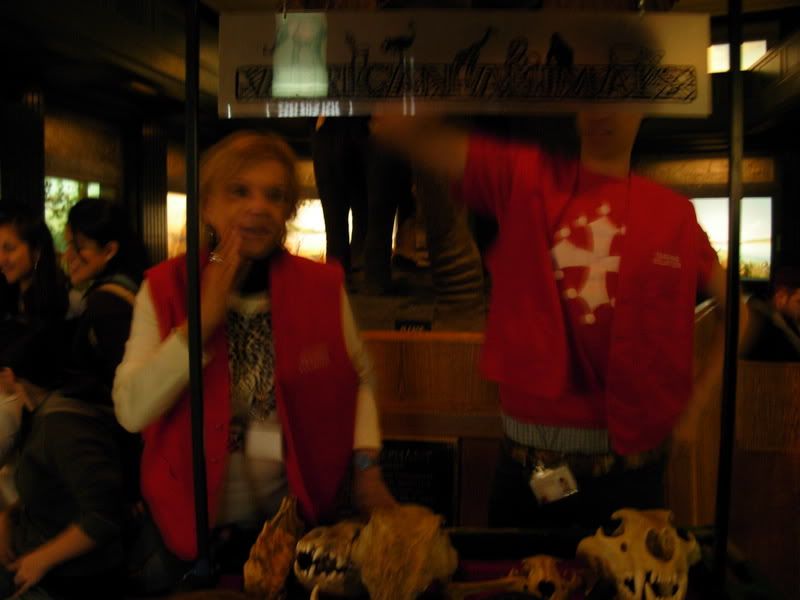
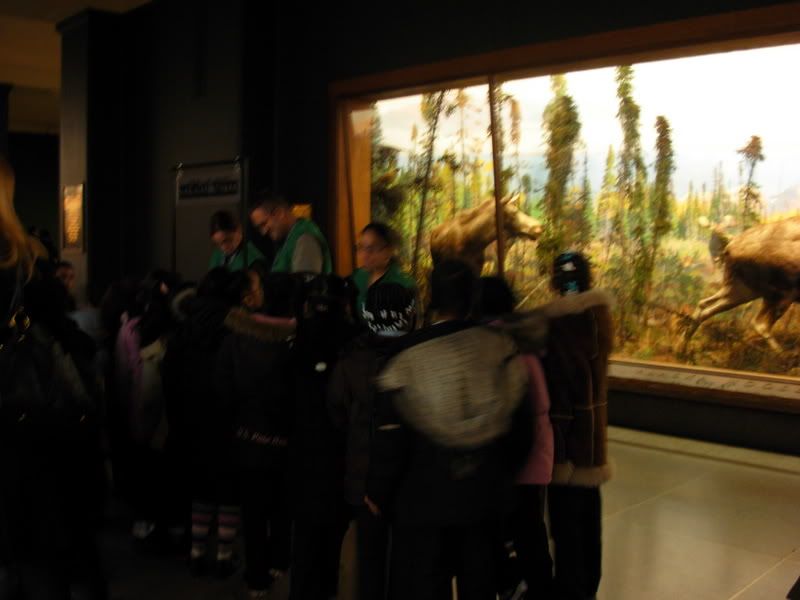
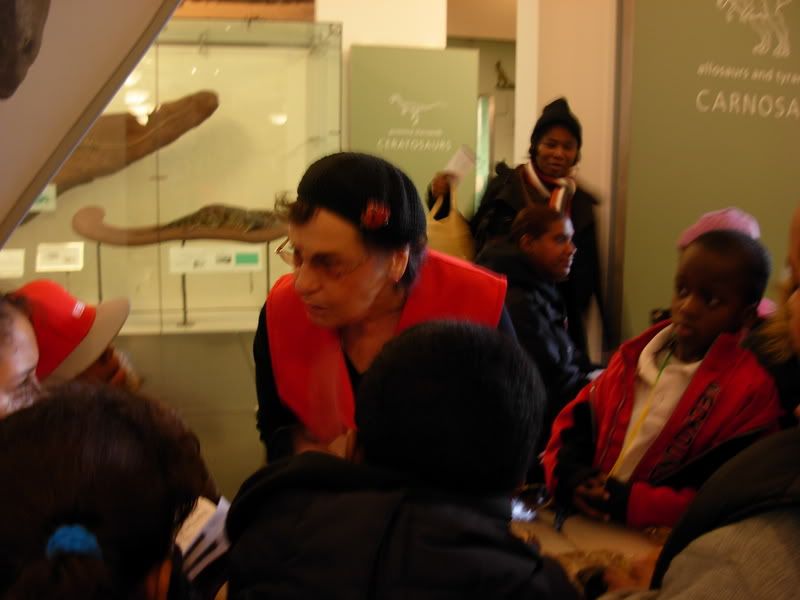
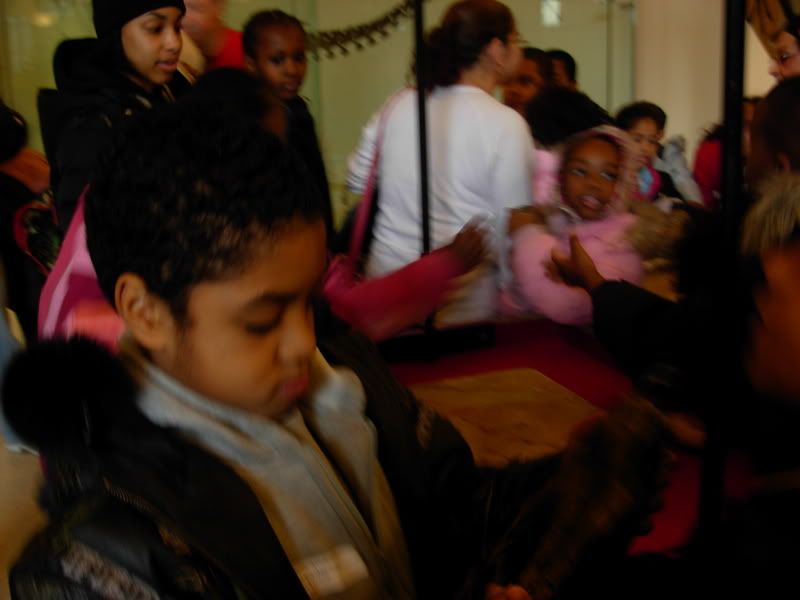
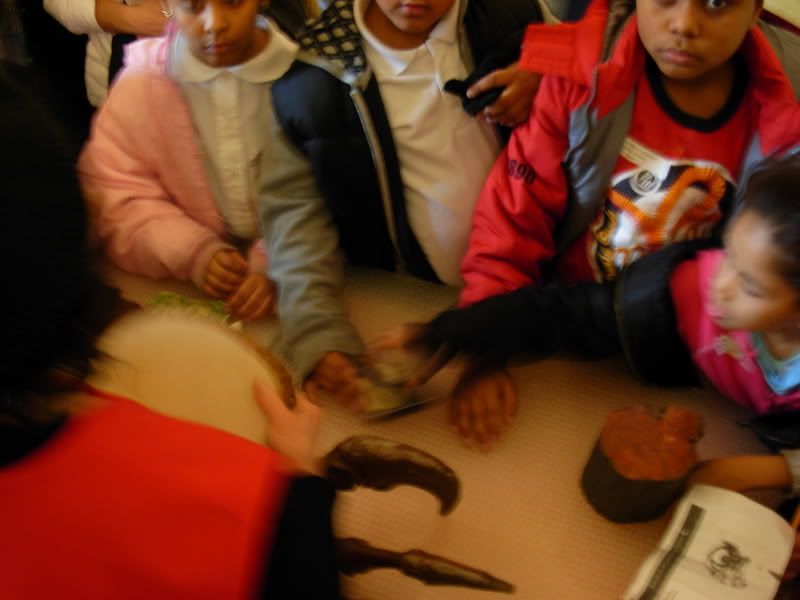
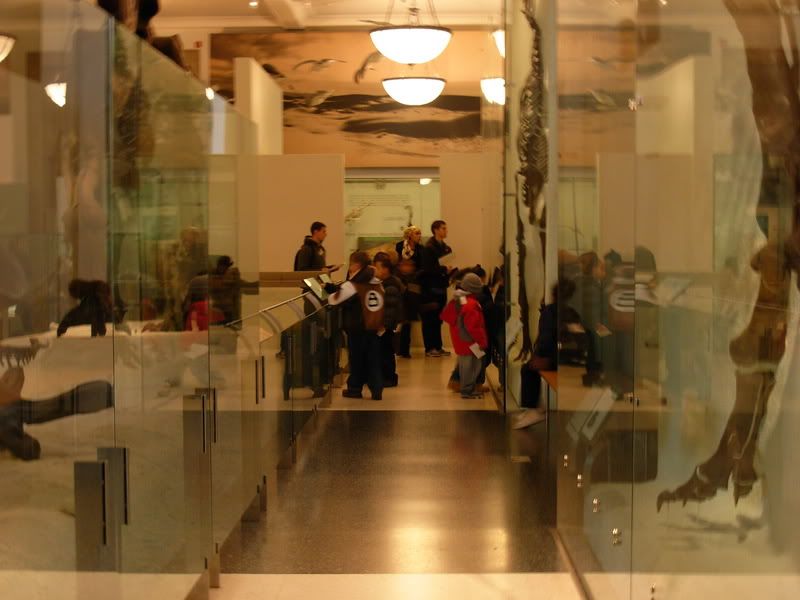

 Buses are not taken to the garage of the museum, as neighbors complained about the amount of noise that used to occur when the buses used to park out front. On this particular day, there was an expected number of 70 buses arriving to the museum.
Buses are not taken to the garage of the museum, as neighbors complained about the amount of noise that used to occur when the buses used to park out front. On this particular day, there was an expected number of 70 buses arriving to the museum. The Teaching Volunteers in this photo are the people who take different carts representing different halls (North American Mammals, African Mammals, Ocean Life) in the museum where students will travel to. On this particular, instead of being assigned to different halls like they normally are, because the program that normally shows the schedule was not working, the volunteers were given the hall of their choice. "You can tell a lot about a person from what hall they use," one of the leaders joked when people would take their time to think very carefully about where they would be teaching. After their meeting, one of the leaders gave a tour of the meteorite room, a sort of orientation, about things the volunteers could mention when showing the room to students.
The Teaching Volunteers in this photo are the people who take different carts representing different halls (North American Mammals, African Mammals, Ocean Life) in the museum where students will travel to. On this particular, instead of being assigned to different halls like they normally are, because the program that normally shows the schedule was not working, the volunteers were given the hall of their choice. "You can tell a lot about a person from what hall they use," one of the leaders joked when people would take their time to think very carefully about where they would be teaching. After their meeting, one of the leaders gave a tour of the meteorite room, a sort of orientation, about things the volunteers could mention when showing the room to students. 
 Before the students, teachers, visiting parents can enter the museum on their own, they must wait in the designated areas. This below photo was one of the first batches of groups to arrive, each section was filled at least ten minute was after the photo was taken.
Before the students, teachers, visiting parents can enter the museum on their own, they must wait in the designated areas. This below photo was one of the first batches of groups to arrive, each section was filled at least ten minute was after the photo was taken. 






 Donna Sethi, who seemed to be my guide, like the missionary was to those who went to study the Yanomami, showed me the ropes of how things are run. She believes that the museum is more kid-friendly than other museums (MoMa, the Met) which she does admit are completely different experiences. In the Lower Level where students meet, there are various trays and boxes where schools places the children's lunch into, so that they won't have to carry them around. A lunchroom has been built (as shown above) where the students can eat at lunchtime.
Donna Sethi, who seemed to be my guide, like the missionary was to those who went to study the Yanomami, showed me the ropes of how things are run. She believes that the museum is more kid-friendly than other museums (MoMa, the Met) which she does admit are completely different experiences. In the Lower Level where students meet, there are various trays and boxes where schools places the children's lunch into, so that they won't have to carry them around. A lunchroom has been built (as shown above) where the students can eat at lunchtime. 







Subscribe to:
Posts (Atom)